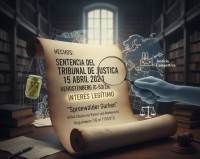Hechos
La sentencia resuelve una cuestión prejudicial remitida por un tribunal inglés en el marco de un litigio de patentes farmacéuticas. Los hechos de los que trae causa el procedimiento principal se resumen a continuación.
La compañía farmacéutica Gilead es titular de una patente y un CCP que protegen el medicamento TRUVADA, un antirretrovírico indicado para el tratamiento de personas infectadas por el VIH. El producto objeto del CCP está compuesto por dos principios activos: el disoproxilo de tenofovir (“DT”) y la emtricitabina. El principio activo DT se menciona expresamente en las reivindicaciones de la patente de base, mientras que el segundo solo podría quedar amparado por la expresión “otros ingredientes terapéuticos” incluida en dichas reivindicaciones.
Varias compañías de genéricos (Teva UK, Accord Healthcare Ltd. y otras) se proponen comercializar versiones genéricas del TRUVADA en el Reino Unido y deciden interponer una demanda instando la nulidad del CCP de Gilead que protege dicho medicamento. La base de la acción es que el CCP no cumpliría con el requisito previsto en el art. 3 (a) del Reglamento nº 469/2009 que exige que el producto objeto del CCP esté protegido por la patente de base, y ello por cuanto que el ingrediente activo “emtricitabina” no figura en el texto de las reivindicaciones de la patente de base de Gilead y, al entender de las demandantes, la expresión “otros ingredientes activos” no se refiere a dicho ingrediente activo de forma implícita pero necesariamente.
El tribunal inglés que conoce de la acción de nulidad decide plantear una cuestión prejudicial al TJ para pedirle aclaración sobre los criterios de interpretación de las reivindicaciones de una patente de base a efectos de determinar si un determinado producto está amparado por la misma. En concreto, le pregunta si basta con que las reivindicaciones de la patente mencionen los principios activos del CCP o se refieran a ellos de forma implícita pero necesariamente, o si es necesario aplicar un criterio adicional.
Pronunciamientos
El TJ, remitiéndose a la doctrina sentada en su último pronunciamiento más relevante en relación con la interpretación del art. 3 (a) del Reglamento nº 469/2009 (sentencia de 12 de diciembre de 2013, Eli Lilly, C-493/12), reitera que solo puede considerarse que el producto objeto del CCP está protegido por la patente de base cuando esté expresamente mencionado o se haga referencia a él necesaria y específicamente en las reivindicaciones de dicha patente. A este respecto, el TJ señala que es necesario garantizar que la protección del CCP se limita a la invención amparada por la patente, tal y como resulta de la descripción y dibujos de la patente, sin ir más allá.
Pues bien, el TJ aclara en esta sentencia que, a tal fin, será necesario comprobar que, desde el punto de vista del experto en la materia y sobre la base del estado de la técnica en la fecha de presentación o de prioridad de la patente, se cumplen las siguientes condiciones:
- Primero, que el producto está incluido necesariamente a la luz de la descripción y de los dibujos de la patente de base, en la invención amparada por dicha patente.
- Y segundo, que el producto es específicamente identificable a la luz de la totalidad de los elementos divulgados por la referida patente.
Comentario
Aunque la sentencia declara que incumbe al órgano judicial remitente comprobar si se cumplen o no los anteriores requisitos en el caso concreto objeto del procedimiento en Reino Unido, lo cierto es que el TJ acaba emitiendo su opinión sobre dicho caso. Así, el TJ señala que, en este caso, la descripción de la patente de base de Gilead no da ninguna indicación sobre que la invención amparada por dicha patente pueda referirse específicamente a un efecto combinado del DT y la emtricitabina para el VIH y que, por tanto, no parece que sobre la base del estado de la técnica en la fecha de presentación o de prioridad de la patente, el experto en la materia pueda comprender que la emtricitabina esté incluida necesariamente, en combinación con el DT, en la invención amparada por la patente.
El pronunciamiento del TJ ha sido acogido por el tribunal remitente (el Tribunal Superior de Justicia de Reino Unido, sección de patentes) que, por sentencia de 18 de septiembre de 2018, ha declarado la nulidad del CCP de Gilead. Al igual que el TJ, el tribunal inglés ha entendido que, al no decir nada la patente sobre la emitricitabina, no hay base para afirmar que, desde el punto de vista del experto en la materia, dicho principio activo está incluido necesariamente en la invención amparada por la patente. Por otra parte, el tribunal inglés ha declarado que tampoco se cumpliría el requisito de que el principio activo sea específicamente identificable a la luz de la totalidad de elementos divulgados por la patente. Sobre este segundo aspecto, el tribunal señala que, aparte de que emitricitabina no se menciona como tal en la patente, tampoco es ni siquiera un miembro de los tipos específicos de compuestos mencionados en la patente, ni hay ninguna evidencia de que en la fecha de prioridad de la patente la emitricitabina era un agente efectivo para el tratamiento del VIH.
Interesa mencionar que en España ha tenido lugar un procedimiento paralelo al de Reino Unido, que ha enfrentado también a Gilead contra Teva y otras compañías de genéricos en relación con las ramificaciones españolas de la misma patente y CCP que fue objeto del conflicto en Inglaterra. Gilead solicitó ante los tribunales de patentes de Barcelona que se prohibiese a Teva (y las otras compañías de genéricos) la comercialización de versiones genéricas de su medicamento TRUVADA en España. Pues bien, los tribunales españoles (v. sentencia de la AP de Barcelona de 18 de diciembre de 2018 - ECLI: ES:APB:2018:7829A) también han acogido el pronunciamiento del TJ en la cuestión prejudicial comentada; en este caso, desestimando la solicitud de medidas cautelares instada por Gilead por entender que no concurría el requisito de apariencia de buen derecho o fumus boni iuris al no cumplir el CCP de Gilead con el requisito del art. 3 (a) del Reglamento nº 469/2009.
Autor: María Cadarso. Anuario Elzaburu, Edición 2018 (recopilatorio de comentarios de jurisprudencia europea en materia de Derecho de Propiedad Industrial e Intelectual que realiza Elzaburu).
Texto de la sentencia proveniente de la base de datos El Derecho Internet Mementos. Más información y posibilidad de probar gratuitamente el producto en https://www.efl.es/catalogo/bases-de-datos-juridicas-de-el-derecho
The CJ defines the criteria for interpreting claims for the purpose of determining whether the product which is the subject of a SPC is protected by the patent. Judgment of the Court of Justice of 25 July 2018, Teva (C-121/17), EDJ 2018/117431.
- Background. The judgment is in response to a referral for a preliminary ruling made by a British court in the context of a dispute concerning pharmaceutical patents. The background to the main proceedings is summarised below.
The pharmaceutical company Gilead is the holder of a patent and an SPC protecting TRUVADA, an antiretroviral medicinal product indicated for the treatment of persons infected with HIV. The product that is the subject of the SPC contains two active ingredients: tenofovir disoproxil (“TD”) and emtricitabine. The active ingredient TD is expressly mentioned in the claims of the basic patent, while the other can only be covered by the phrase “other therapeutic ingredients” included in the claims.
Various generic manufacturers (Teva UK, Accord Healthcare, and others) intended to market generic versions of TRUVADA in the United Kingdom and decided to bring an action seeking to challenge the validity of Gilead’s SPC protecting that medicinal product. The basis for the action was that the SPC did not satisfy the condition stipulated in Art. 3(a) of Regulation no. 469/2009 that the product that is the subject of the SPC is protected by the basic patent, given that the active ingredient “emtricitabine” is not specified in the text of the claims of Gilead’s basic patent, and the applicants challenging the validity of the SPC in the proceedings considered that the expression “other active ingredients” did not relate implicitly but necessarily to said active ingredient.
The British court hearing the action decided to refer a question to the Court of Justice for a preliminary ruling, seeking clarification on the criteria for interpreting the claims of a basic patent for the purpose of determining whether a given product is covered by the same. Specifically, it raised the question whether it is sufficient that the patent claims mention the active ingredients of the SPC or relate to them implicitly but necessarily, or whether it is necessary to apply an additional criterion.
- 2. The Court of Justice, referring to its most recent settled case-law concerning the interpretation of Art. 3(a) of Regulation 469/2009 (judgment of 12 December 2013, Eli Lilly, C-493/12), reiterates that the product which is the subject of the SPC can only be regarded as protected by the basic patent when it is expressly mentioned in the claims of the patent or those claims relate to it necessarily and specifically. In this regard, the Court of Justice indicates that it is necessary to ensure that the protection of the SPC is limited to the invention covered by the patent, as it appears from the description and the drawings of the patent, and not extending beyond the invention.
In this judgment, the Court of Justice clarifies that, to this end, it is necessary to ensure that from the point of view of a person skilled in the art and on the basis of the prior art at the filing date or the priority date of that patent, the following conditions are met:
- Firstly, that the product, in the light of the description and the drawings of the basic patent, is necessarily included in the invention covered by said patent.
- Secondly, that the product is specifically identifiable in the light of all the elements disclosed by that patent.
- 3. While the judgment declares that it is for the referring court to ascertain whether or not the aforementioned requirements are met in the specific case at issue in the proceedings in the United Kingdom, the Court of Justice does ultimately issue its opinion on the case. The Court of Justice thus states that, in this case, the description of Gilead’s basic patent does not contain any indication that the invention covered by that patent could relate specifically to a combined effect of DT and emtricitabine for the treatment of HIV and, therefore, that it does not seem possible that a person skilled in the art, on the basis of the prior art at the filing date or the priority date of the patent, could consider that emtricitabine, in combination with DT, necessarily falls under the invention covered by the patent.
The Court of Justice’s ruling has been accepted by the referring court (the High Court of Justice of England & Wales) which, in a judgement dated 18 September 2018, declared Gilead’s SPC invalid. The British court, like the Court of Justice, found that since the patent makes no mention of emtricitabine, there is no basis for maintaining that from the perspective of a person skilled in the art, that active ingredient is necessarily included in the invention covered by the patent. Moreover, the British court declared that the requirement that the active ingredient is specifically identifiable in the light of all the elements disclosed by the patent, is not satisfied either. With regard to this latter aspect, the court found that in addition to not being specifically mentioned in the patent, emtricitabine was not even a member of a specific class of compounds mentioned in the patent, and there is no evidence either that at the priority date of the patent, emtricitabine was known to be an effective agent for the treatment of HIV.
It is also important to mention that there have been proceedings in Spain in parallel to the proceedings in the United Kingdom, which again brought Gilead up against Teva and other generics manufacturers, in relation to the ramifications in Spain of the same patent and SPC that was the subject of the conflict in the UK. Gilead brought an action before the patent courts of Barcelona seeking to bar Teva (and the other generics manufacturers) from marketing generic versions of its TRUVADA medicine in Spain. The Spanish courts (see the judgment of the Barcelona Court of Appeal of 18 December 2018 - ECLI:ES:APB:2018:7829A) also accepted the Court of Justice’s ruling in relation to the question referred for a provisional ruling, in this case dismissing the petition by Gilead for interim relief, finding that it had not been shown that there was a prima facie case (fumus boni juris), since Gilead’s SPC did not satisfy the requirement laid down in Art. 3(a) of Regulation no. 469/2009.
ElDerecho.com no comparte necesariamente ni se responsabiliza de las opiniones expresadas por los autores o colaboradores de esta publicación








